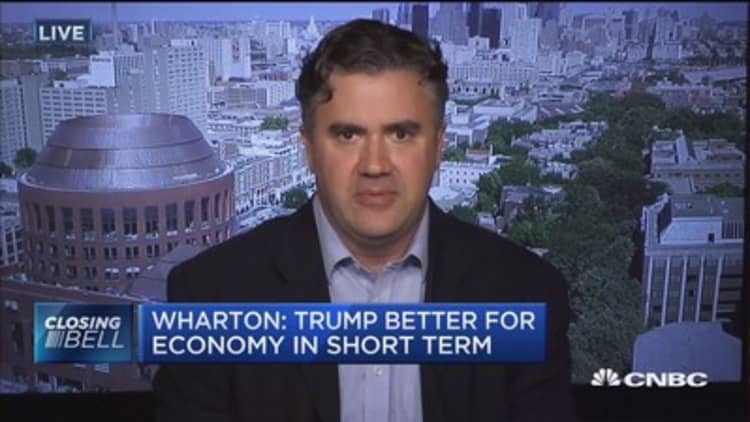
Donald Trump's tax plan could provide a boost to economy in the short term, but Hillary Clinton's plan will be better for the long term, a new report from Wharton's School of Business found.
The analysis stated that the Republican nominee could initially boost job creation by 1.7 million, but by 2027 there may be 682,000 fewer jobs than current economic conditions. In 2040, it could mean 11.2 million fewer jobs than are currently in place.
In contrast, Clinton's plan could result in 282,000 jobs lost in 2018, but then it swings in the other direction. By 2027, the Democratic nominee's plan could mean 645,000 more jobs in 2027 than are in the current economy and in 2040, it projects 2 million more jobs than the current rate.
The same trajectory happens with the two plans' effect on gross domestic product, with Trump initially pushing it 1.12 percent higher before it reverses course. The Democratic nominee's plan would send GDP lower at first, but then it would climb higher.
Kent Smetters, Wharton School professor and interim director of the Penn Wharton Public Policy Initiative, told CNBC's "Closing Bell" there is a "crucial link" the report makes that other models are missing.
"Our model takes the additional deficits that are created by any plan into account," he said.
"In particular if the economy is an open economy, similar to the United States today, and we have capital flows that we've seen historically, then as the government produces new debt, that debt competes with private capital for household savings as well as international capital flows."
Another critical component of the report is the fact that it uses dynamic scoring as opposed to static analysis, Smetters said.
"Traditional projections have sometimes been called static analysis, and they don't account for the impact a tax plan may have on the economy, on jobs, on inflation and other macro-level issues," he noted.
Smetters said the analysis is "all about the numbers" and the results are a projection of what would happen if the plans pass. However, he acknowledged that the makeup of Congress and therefore the ability of a candidate to get his or her plan through is uncertain.
Clinton's plan includes a tax hike on high earners, increasing the child tax credit and reforming capital gains taxes. Trump wants to reduce marginal tax rates, increase standard deduction amounts and reduce the corporate tax rate to 15 percent.
In a statement, Dan Kowalski, Trump's deputy policy director, said that the analysis only looked at a small portion of Trump's overall economic plan.
"The Trump economy achieves 4 percent growth, adds at least 25 million new jobs, and generates at least $2.4 trillion in positive revenue offsets when the positive effects of a reduced regulatory burden, the unleashing of our energy sector, and the elimination of our trade deficit are taken into account," Kowalski said.
"The Trump plan will boost growth both in the short run and the long run."
— CNBC's Stephen Desaulniers contributed to this report.


